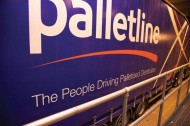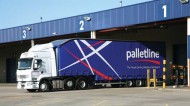 Palletline has achieved a leading position among UK pallet networks in recent years through a combination of progressive management, investment in IT and infrastructure and distinctive branding. This has raised Palletline’s profile among customers and attracted high profile members of other networks to join, fuelling Palletline’s growth and underpinning its reputation as the UK’s foremost network, if not in size, in service levels.
Palletline has achieved a leading position among UK pallet networks in recent years through a combination of progressive management, investment in IT and infrastructure and distinctive branding. This has raised Palletline’s profile among customers and attracted high profile members of other networks to join, fuelling Palletline’s growth and underpinning its reputation as the UK’s foremost network, if not in size, in service levels.
Recognising the paramount importance of the need to work ‘smarter,’ when they moved hubs Palletline’s management didn’t seek to achieve the biggest hub in the sector, which became an important factor in the recession. Instead, in planning the new facility they focused on thinking through their operational requirements and redefining Palletline’s working requirements to improve efficiency, throughput and operational safety.
Led by Managing Director Kevin Buchanan, Palletline continues to innovate in IT and recently became the UK’s first pallet network to introduce a Virtual Supply Chain information application for its members and an Automated Service Failure ID system. This gives Palletline and its members an edge in identifying problems and revising practices. Kevin Buchanan spoke to Warehouse & Logistics News.
Warehouse & Logistics News – When was Palletline founded? Are the founders still involved?
Palletline was founded in February 1992. The original members included Bob Russett, MD of Palletline Logistics in Birmingham, Robert Rushworth, MD of Expect Distribution in Bradford, and Ken Hackling, of Hackling Transport, Gloucestershire, Ken and Robert are both still on the board as non-executive directors.
WLN – Who are the other leading member companies?
The other leading members in England include Gregory Distribution, Edge Distribution, Wrexham, Global Distribution in Manchester and House of James in York. Members in Scotland include ARR Craib, Aberdeen, one of the country’s largest pallet transport companies, who are in a pallet network for the first time, and Gordon Leslie Distribution, who recently joined and are on the west side of Glasgow, but these are just a few, because all of our members are leading companies in their areas.
WLN – How many depots and vehicles are there in total?
We have 76 members actively inputting and collecting pallets. We have gained 20 new members in the last two years, almost a one-third increase in membership.
Over 2,000 vehicles are deployed to Palletline business every day, and we potentially have 10,000 vehicles available. Where we differ is that all members are substantial haulage outfits in their own right, either regional heroes or pan-European businesses and typically much larger than companies in other networks.
WLN – What happens when companies join?
After six months’ probation, we confirm companies as full members. They must all purchase a minimum of 2,000 shares.
WLN – Can non-members buy shares in Palletline PLC?
 You must be a member to buy shares: they’re not openly available. We gear the whole business on Members retaining financial control. It’s a great example of a commercial co-operative. We only do what’s best for them collectively even if sometimes individually it doesn’t seem so
You must be a member to buy shares: they’re not openly available. We gear the whole business on Members retaining financial control. It’s a great example of a commercial co-operative. We only do what’s best for them collectively even if sometimes individually it doesn’t seem so
WLN – Who decides policy?
The Executive team develops strategy and policy, and the non-executive directors ratify it, acting as a check and balance as to what is good for the member network.
WLN – Do members have a say?
They do, very much so. It’s better to win the argument and take people with you. We held a special members’ meeting regarding the current business plan. It involved buying the new hub, so it was only right to let them have an input. As it turned out, they accepted the plan unanimously.
WLN – How long have you been MD?
I’ve been MD since May 2007. I was previously working in other transport businesses, such as the NFC. Latterly I was running TWT Logistics South Wales.
WLN – What does your role involve?
Day to day, I’m in charge of running the overall business, implementing our business strategy and addressing business issues, including ensuring Palletline is the best in the sector and maintains its lead.
I also have hands on responsibility for member recruitment, and spend eighty percent of my time with our network members. My background is running transport businesses at the sharp end, so I think I talk their language.
WLN – Where does Palletline rank among UK networks?
Our aspirations are not to be the biggest by volume, but the best in quality and reliability. Chasing volume is a fool’s game: recently it’s forced prices lower and driven the market down, benefiting hub owners and venture capitalists to the detriment of member companies.
Pallet networks are there to achieve efficient freight movements, but if your policy is to input volume at any cost, you end up working at a loss, resulting in other problems, such as higher damage levels and poor quality standards.
WLN – Why choose Palletline?
We offer the best service, technology and value, and customers know they’re getting their delivery on time, in the right place. We’ve recruited a third more members in the last two years, which is an added strength. Some members used to cover large areas and as their volume of freight has grown it’s been harder to reach some delivery points. Hence we’ve been strengthening some areas such as Scotland, and it’s all now much more manageable, with balanced trunking in and out.
In London we had too small a network before: we’ve recruited five or six members in the last two years, covering smaller delivery areas in what is a very congested city.
The trick in managing growth is ensuring you keep control. When I meet a potential new member I look at how committed they are to doing things right. The people we’ve taken on recently are substantial haulage businesses in their own right, and include former members of Palletways, Palletforce and Pallex.
WLN – Do you cover Europe and Ireland as well?
 Yes, we do. We have a new member in Southern Ireland, JMC Van Trans, and DSV in Belfast, Northern Ireland. Europe is more of a challenge because there are so many national specialists and the freight flows are different. Freight transport prices are more likely to be calculated by weight not pallets, and there’s no overnight network ethos.
Yes, we do. We have a new member in Southern Ireland, JMC Van Trans, and DSV in Belfast, Northern Ireland. Europe is more of a challenge because there are so many national specialists and the freight flows are different. Freight transport prices are more likely to be calculated by weight not pallets, and there’s no overnight network ethos.
That said, we are launching our European product in November, with daily services to 26 countries. We have a fully integrated system with our European partners, working on a reciprocal basis with full track and trace capability.
WLN – Which members have joined in the last few months? Who were they with?
Olivers and Nivens, ARR Craib – all in Scotland and TM Logistics in the Midlands; none of whom were previously with a network: PF Whitehead in Croydon and Welsh Transport came from Palletways; Gordon Leslie was with Palletforce.
WLN – What’s drawing these people to you?
In the last few years we’ve taken a higher profile and become more dynamic and commercially savvy. We have three ISO standards, confirming we run efficiently and professionally. Also, external market pressures have made the leading independent hauliers take a new look at their business and think about membership of a pallet network.
WLN – What are the benefits of joining Palletline?
Members gain access to shareholder colleagues with the same principles and approach. At a practical level they have the chance to distribute freight more cost-effectively. We keep the cost to the membership lower than any other network: it typically costs less than other networks to transact a pallet, hence members can retain more margin.
WLN – Are you looking for new members? What characteristics must they have?
They must be established successes, strong financially and have the right quality ethos and infrastructure, and understand what’s involved in being part of a network. We look for likeminded people who can bring value to the network.
WLN – We last spoke a couple of years ago. How’s life at Palletline been since then?
Back in 2007, when we were celebrating our 15th anniversary, we looked at what we could do better. This highlighted the need to relocate our hub in Birmingham and diversify our product offering, including a European multi-pallet service, freight exchange on a commercial basis, and evening/night delivery and home delivery transactions.
WLN – When did you move into the new hub?
We moved to Starley Way, Solihull in late 2008, just when the recession struck. We’d made conservative assumptions about volume and were cost-efficient from the start. Moving to the new hub substantially reduced our operating costs, but it was still a challenging time, but beneficial.
WLN – What effect did the recession have on you?
The recession was a spur to greater efficiency and enabled us to justify our investment in improvements. For the first time ever the industry had flat volumes from late 2008 to late 2009, so it was a distinct advantage that we weren’t on fixed rent with a big empty hub.
WLN – How big is the new hub?
 It’s not the UK’s biggest hub, but it’s the most efficient. It’s a 15-acre site, based on the rolling floor concept of constant unloading and reloading. We’ve segregated duties, giving a more efficient process.The main hub is 180,000 square feet, with an additional 50,000 square feet of loading canopies. We unload 6-8 vehicles every 10 minutes and reload 22 vehicles every 30 to 40 minutes. We have 50,000 square feet dedicated to quality control, set out like a tollbooth area, and video and scan every pallet. We’ve seen 15% growth for February/July 2010 versus 2009. Between Easter and May we were processing over 11,000 pallets per night.
It’s not the UK’s biggest hub, but it’s the most efficient. It’s a 15-acre site, based on the rolling floor concept of constant unloading and reloading. We’ve segregated duties, giving a more efficient process.The main hub is 180,000 square feet, with an additional 50,000 square feet of loading canopies. We unload 6-8 vehicles every 10 minutes and reload 22 vehicles every 30 to 40 minutes. We have 50,000 square feet dedicated to quality control, set out like a tollbooth area, and video and scan every pallet. We’ve seen 15% growth for February/July 2010 versus 2009. Between Easter and May we were processing over 11,000 pallets per night.
WLN – What’s different about the new hub?
The old site was 61/2 acres, long and narrow. The new one is 15 acres and is rectangular with less restriction on vehicles, and takes 150 stand trailers. It’s a more efficient and flexible resource. We have a safer, better quality facility with greater capacity, which has unique operating standards in the industry.
WLN – What did it cost?
We spent £20m on the whole project, funded through bank borrowing, cash in the business and the value of the old site. We have a mortgage on the site, but it’s less than paying market rent on a leased property and can only reduce. I wouldn’t swop places with any other network! It’s a bit like owning your own home; rent is money with no return.
WLN – What IT system have you got?
The new central hub includes a new scanning system: we’ve invested £1/2m in scanners designed in conjunction with Belgravium, to improve scanning and make it more efficient. We’ve given these to every member: some networks just have a few scanners for an entire network and only scan freight into the Hub!
Track and trace is only as good as the network coverage. We offer it throughout a pallet’s journey, with six-point scanning and digital signature at point of delivery. Again no one else offers this.
Our scanners also have auto discrepancy ID and photo capability. If we are concerned about freight presentation, we can raise a discrepancy and take a photograph in seconds, the data uploads onto the shipment file, establishing the point of liability and full details for the members. This enables members and customers to focus on vital areas such as freight presentation.
WLN – What does your virtual supply chain (VIS) application do?
VIS enables the integration of large quantities of data to manage the supply chain, which is made openly available to all members, including scanning, discrepancy ID and a Virtual Hub application.
The Virtual Supply Chain shows where everything is. It takes out the panic by locating everything accurately and managing by exception, boosting customer confidence and efficiency.
WLN – When did it go live?
 Our virtual supply chain went live in January 2010.
Our virtual supply chain went live in January 2010.
WLN – Similarly, what does your Automated Service Failure ID System do?
We time delivery of goods into the regional DCs, and the system then looks for GPS positioning and delivery signature by a set time.
With around 90% of Palletline’s deliveries captured on digital signature, we can say where things are and create immediate failure reports so members can take action and advise customers. It’s about confidence based on improved communication and complete transparency.
WLN – What percentage of full loading are your vehicles running at now?
According to Association of Pallet Network stats, the industry average is 85% full load, and we’re in line.
In the recession vehicles were running half empty and fleets were shrinking. From December 2009 we’ve seen an improved picture, since then volumes have increased and so has vehicle fill.
WLN – Are others emulating your ideas as best practice? How do you stay ahead?!
We’re not too paranoid about our competitors: we’re single minded about focusing on quality, not bringing prices down. We’re not tied to profit demands of a VP which enables us to invest where others can’t. I don’t know anyone else in the network sector spending £1/2m-£1m per annum on technology advancements.
WLN – Have you won any industry awards, and what were they for?
We take an active part in industry awards, to demonstrate that we’re consistently better and invest more in technology than other networks. We won the RoSPA Award for Safety in 2010: we were finalists in this year’s Motor Transport Awards, we’re in the finals of the IFW Awards and The Grocer Gold Awards, and also the CILT and European Supply Chain Excellence Awards and Orange Business Awards, which are coming up.
WLN – What do you see as the biggest problems now for the UK pallet network industry?
The biggest problems are over-capacity and marginal pricing. Financial pressure on hauliers to fill trucks is the road to ruin. The fuel situation is also dire: networks as a concept help achieve efficiency, but fuel is still very expensive. We need stronger lobbying– no government in 25 years has paid any attention to road transport.
WLN – So what can pallet networks do?
With such lean margins in road transport, it’s very difficult for operators just to be pallet network members. They need to evolve and become part of a supply chain solution, with pick and pack and other functions. The sector needs to broaden its appeal by taking on more shared user business, and invest in efficiencies and quality people.
WLN – Finally, where do you see Palletline going from here?
We’ve still got a fair way to go with product diversification. As I mentioned, these include evening/night time deliveries, launching our European product this year, extended home delivery services, and possibly even two-man services. We want members to be able to provide a one-stop shop and so identifying market opportunities that we can use our unique structure to exploit.
We’re also looking at adding value for our members by such measures as buying diesel and fork lifts cheaper, and generally operating more efficiently. It all comes down to committing ourselves to helping Palletline grow in stature as a broader commercial co-operative, bound together with a common quality ethos, which will help us achieve even greater things.
Palletline PLC Tel: 0121 767 6870 www.palletline.com




Comments are closed.